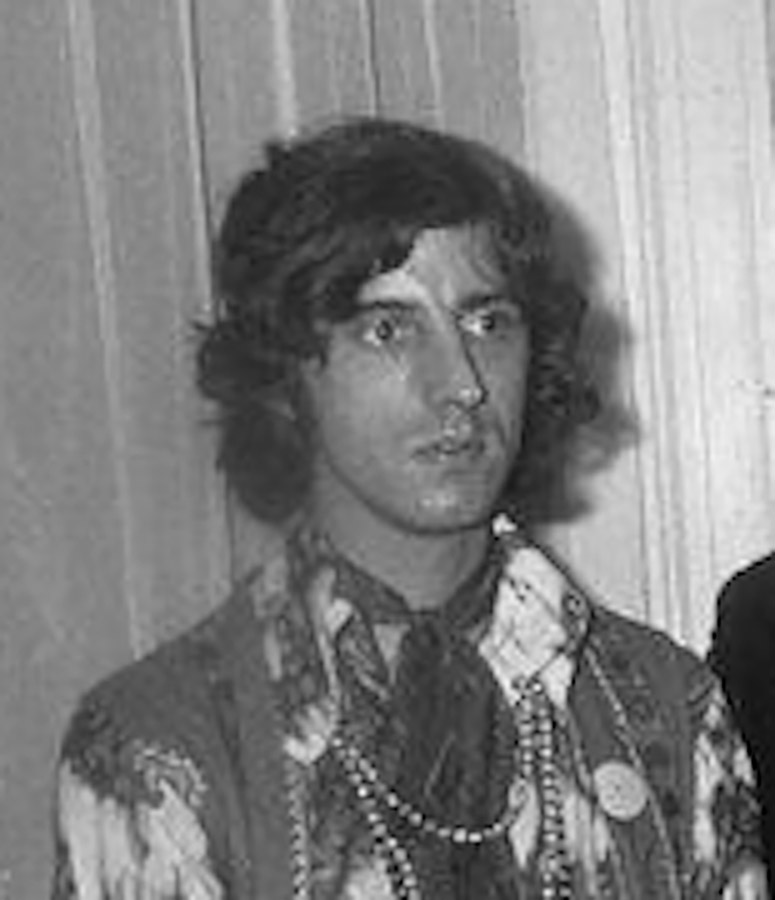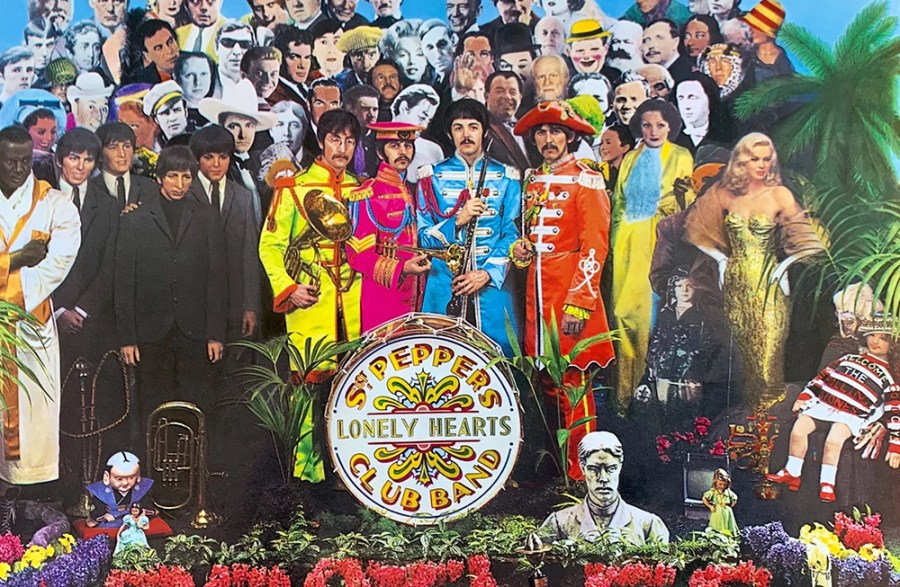Steve Fairclough reveals the intricate tale of the major players involved in creating the classic The Beatles album cover Sgt. Pepper’s Lonely Hearts Club Band…
Fact File: The Beatles’ Sgt. Pepper’s Lonely Hearts Club Band
Musicians: George Harrison, John Lennon, Paul McCartney, Ringo Starr, Sounds Inc. (horns), Neil Aspinall, Geoff Emerick, Mal Evans, George Martin.
Released: 26 May 1967 (EMI).
Best chart performance: No. 1 in the US, UK, West Germany, Australia, Canada, Finland, Norway, Sweden.
Sales: Over 32,000,000 certified sales.
Fascinating fact: There is some dispute over exactly who shot the cover, with Cooper’s assistant on the day, Nigel Hartnup, telling the music magazine MOJO he had released the shutter. The stage set’s images of famous people were created by shooting pictures from image libraries and enlarging them to life-size on 20x16in paper. They were then sent off to be professionally mounted.
The creation of arguably the most iconic album cover ever produced involved a misheard request for salt and pepper, Indian gurus, an art dealer nicknamed ‘Groovy Bob’, Day-Glo satin uniforms, specially made props, pop art legend Peter Blake and a young photographer who died tragically within six years of shooting the cover; it can only be Sgt. Pepper’s Lonely Hearts Club Band.
At the heart of the idea was that The Beatles just didn’t want to be The Beatles any more and the ‘glue’ that brought that idea to fruition was London art dealer Robert Fraser (aka Groovy Bob). It was Fraser who commissioned pop artist Peter Blake, and his then wife Jann Haworth, for the Sgt. Pepper’s cover concept.
In the 2017 Sky Arts documentary, Peter Blake: Pop Art Life, Blake explained, ‘It was a concept. They didn’t want to be The Beatles any more; they wanted to do something different and Robert Fraser said, “Why don’t we use a proper artist and do something different?” They’d had the uniforms made, but the idea of the crowd was my idea. I’d used crowds a lot until then. I’d done a whole series of collages of circus using the crowds as a motif.’
Salt and pepper
In a 2017 interview, Paul McCartney revealed, ‘I was coming back from a trip abroad with our roadie, Mal Evans. We were eating and he mumbled to me to pass the salt and pepper. I misheard him. I thought he said, “Sergeant Pepper”. I went, “Oh! Wait a minute, that’s a great idea!” We had a laugh about it, then I started thinking about Sergeant Pepper as a character. I thought it would be a very interesting idea for us to assume alter egos for this album we were about to make.’
McCartney added, ‘I started doing drawings of how the band might look. I sort of got this military look thing going and one of my ideas was that they were being presented by the Lord Mayor of some northern town in a park. In the old days they used to have floral clocks – a clock made of flowers. I did drawings of the floral clock and then, “Sgt. Pepper’s Lonely Hearts Club Band”, aka The Beatles, getting some sort of award from the town.’
Blake recalled, ‘I offered the idea that if they had just played a concert in the park, the cover could be a photograph of the group just after the concert with the crowd who had just watched the concert. If we did this by using cardboard cut-outs, it could be a magical crowd of anyone they wanted from history. The Beatles each made a list of people. Paul and John chose a lot – both really interesting lists. George only chose Indian gurus and Ringo said, “Oh, leave it to the lads.” He didn’t choose anybody.’
Stage set
At first glance, many think the cover of Sgt. Pepper’s is a collage, but it was in fact a photograph by Michael Cooper. Blake recalled, ‘It was like a stage set. So, the figures were life-size and most of them were plywood cut-outs. The Beatles arrived with their entourage with Robert [Fraser] and took the pictures.’
The centre of the cover depicts the Beatles standing behind a bass drum on which fairground artist Joe Ephgrave had painted the words of the album’s title as SGT: PEPPERS LONELY HEARTS CLUB BAND. Two drum skins were painted and the one chosen used a colon below the GT in ‘SGT’ and left out an apostrophe after the R in PEPPERS.
Jann Haworth made props for the stage set, including a doll of Shirley Temple that appears on the LP. In a 2017 BBC interview she said, ‘My vision was to do it as a set and that is supported by my work at the time. The crowd really is Peter’s [Blake’s] idea.’ She was also responsible for the idea of spelling out BEATLES in flowers. ‘The idea of doing lettering like that, I just loved, so I suggested that as another form of lettering, besides the drum, that would keep the integrity of the cover.’
Satin uniforms
The Beatles’ colourful satin, military-style uniforms were specially made by the London theatrical costumer, M Berman Ltd. There was no specific reason behind who wore what colour, as McCartney revealed in 2017, ‘We just chose a material. Said, “I’ll have that, he’ll have that”. It was just whoever wanted what colour.’ Next to the real-life Beatles were waxworks of the band from the Beatlemania era, which had been borrowed from Madame Tussauds.
In total, the stage set included 57 photos and nine waxworks. The group included the deities Buddha and Lakshmi; singers Bob Dylan and Bobby Breen; film stars Marlon Brando, Tony Curtis and Marlene Dietrich; comedians Laurel and Hardy; boxer Sonny Liston; writers HG Wells, Oscar Wilde and Dylan Thomas, and the scientists and philosophers Albert Einstein and Carl Jung. EMI, the record company, rejected John Lennon’s requests for images of Adolf Hitler and Jesus Christ and George Harrison’s for Mahatma Gandhi.

John Lennon (left) and Ringo Starr (right) inspect the stage set before the Sgt. Pepper’s photo shoot
The 30 March 1967 photo session with Michael Cooper – shot on a Sinar 5x4in camera – also produced the back cover and the inside gatefold image of the band. McCartney recalled the inner-gatefold image, ‘We all said, “Now look into this camera and really say I love you! Really give love through this!” If you look at it you’ll see the big effort from the eyes.’ But according to John Lennon, Cooper’s photos of the band showed, ‘two people who are flying [high on drugs], and two who aren’t.’
The final cost for the cover art was nearly £3,000 (equivalent to just over £49,000 today), which was a very extravagant sum for a time when album covers would typically cost around £50 (£820 today).
Lyrics on back cover
The album’s lyrics were printed in full on the back cover – the first time this had ever been done on a rock LP. The inner sleeve featured artwork by Dutch design team the Fool – artist Marijke Koger and her partner Simon Posthuma – which eschewed, for the first time, the standard white paper in favour of an abstract pattern of waves of maroon, red, pink and white. Only the first pressing of the LP included this element, and it’s no longer available today.
Included as a bonus gift was a sheet of cardboard cut-outs designed by Blake and Haworth. These consisted of a postcard-sized portrait of Sgt. Pepper, based on a statue from Lennon’s house that was used on the front cover, a fake moustache, two sets of sergeant stripes, two lapel badges and a stand-up cut-out of the Beatles in their satin uniforms.

Preparing for the Sgt. Pepper’s Sgt. Pepper’s Lonely Hearts Club Band shoot (foreground, from left to right, faces visible): Mal Evans, Paul McCartney and photographer Michael Cooper
Some time after the photo shoot, the head of EMI, Sir Joseph Lockwood, visited McCartney’s house and demanded that letters be sent to seek permission to use the likenesses of the people in the stage set. According to McCartney, all of them agreed bar ‘one of the Bowery Boys who wanted to cut a deal.’
Peter Blake said of the album cover, ‘I feel enormous pride in having done it. If I’m in a cab I know that the instant I admit I did Sgt. Pepper’s, then we’ve communicated. There’s only ever been one black cabbie who said, “Nah, I’ve never heard of that mate,” and I think he might have been winding me up. But if people bought it, and it introduced them into a world of other art and fine art, I’m very happy about that.’
Michael Cooper

Michael Cooper (1941-73) was a British photographer who is remembered for his images of leading rock musicians of the 1960s and early 1970s. His best-known work is the cover photography for Sgt. Pepper’s, but he also created the cover lenticular for the Rolling Stones’ LP Their Satanic Majesties Request. He died by suicide, after becoming caught in a spiral of depression and heroin addiction.
The panel on Sgt. Pepper’s Lonely Hearts Club Band
Christie Goodwin

There had been a gradual evolution with what artists did on their album covers, pushing creativity always a tiny bit further. With the cover of The Beatles’ Sgt. Pepper’s LP, Peter Blake broke all boundaries and expanded our notion of creative possibilities. It was a visual gamechanger.
Aubrey Powell

The Beatles had taken a step forward in making the LP cover an important art form. It was an intentional design. There were decisions on the day of flowers and plants to fill spaces, and how The Beatles should be arranged within the staging, but by and large the geometry and design remained as conceived. Genius.
Rankin

Possibly the greatest album cover of all time. It’s conceptual, it has two versions of the band, every celebrity that was important, plus it represents the music perfectly. Add to this that it is realistically photographed, with photography at its heart. Finally, it’s made by one of the greatest British pop artists, Peter Blake.
Our panel of judges
Some of the finest names in music, design and photography chose their favourite album covers for this series – they are:
Janette Beckmann
Jason Bell
Harry Borden
Ed Caraeff
Andy Cowles
Kevin Cummins
Dr Andy Earl
Jill Furmanovsky
Christie Goodwin
Peter Hook
Simon Larbalestier
Gered Mankowitz
Dennis Morris
Peter Neill
Aubrey ‘Po’ Powell
Rankin
Jamel Shabazz
Mat Snow
Howard Wakefield
Kirk Weddle
Rachael Wright
Further reading:
Greatest album photography: Sticky Fingers by the Rolling Stones












